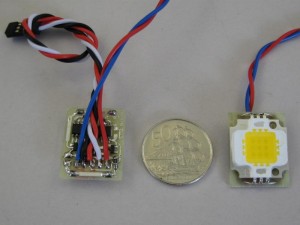CAUTION *** Do not look directly at the strobe light at close range *** CAUTION
 Introduction
Introduction
This is a single White strobe designed to increase the visibility of RC gliders, planes and multirotors. Designed with large gliders and FPV in mind.
It can be used on other models and applications suck as a fishing kontiki if fitted to be waterproof.
Purpose:
- orientation determination at a distance (large gliders)
- visibility aid (strobe/beacon to make visible to others)
Without the RC control connection, the default operation is a dual strobe repeating at 1-second intervals.
With RC control the options are:
- off
- triple strobe
- single strobe
The dual strobe still operates if the control signal is outside of standard 1000-2000 uS PPM.
The RC control allows on-off control while flying and indication of RC status, ie. fail-safe or loss of RC, depending on your transmitter programming.
Installation
Mount so as to face and be visible from the desired direction.
On a large glider this may require one strobe on each side of the fuselage and possibly one facing forward. This should allow orientation determination at a distance.
WARNING: do not operate at greater than 12.6V supply (LED current will be too high)
Connect the 12V power lead to the 3-cell Lipo battery. RC connection is not generally required and will produce the default double-strobe pattern.
The strobe is reverse reverse polarity protected, but your RC receiver may not be if connected to the strobe. The best option, don’t reverse connect the power.
Technical Notes
Supply voltage is 10 to 12.6V. The strobe intensity is greater at 12.6V and reduced slightly at 10V. This suits operation from a 3-cell Lipo. Peak current draw is approx. 1.5-Amps but average current draw is typically less than 100mA. Individual pulse duration is typically 20mS. Average power dissipation is low, therefore heatsinking or special cooling is not required.
WARNING: do not operate at greater than 12.6V supply (LED current will be too high)
Peak LED current:
- 12.6V (2.25V@1.2R) = 1.8A
- 12V = (1.9V@1.2R) = 1.5A
- 11.5V = 1.3A
- 11V = 1A
- 10V = 0.6A
.